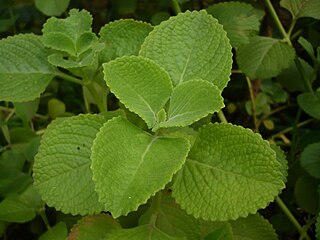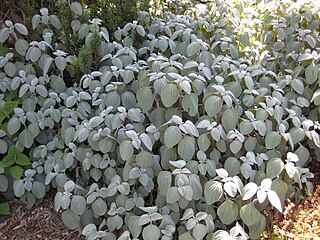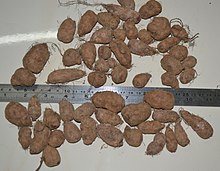
The Lamiaceae or Labiatae are a family of flowering plants commonly known as the mint, deadnettle, or sage family. Many of the plants are aromatic in all parts and include widely used culinary herbs like basil, mint, rosemary, sage, savory, marjoram, oregano, hyssop, thyme, lavender, and perilla, as well as other medicinal herbs such as catnip, salvia, bee balm, wild dagga, and oriental motherwort. Some species are shrubs, trees, or, rarely, vines. Many members of the family are widely cultivated, not only for their aromatic qualities, but also their ease of cultivation, since they are readily propagated by stem cuttings. Besides those grown for their edible leaves, some are grown for decorative foliage. Others are grown for seed, such as Salvia hispanica (chia), or for their edible tubers, such as Plectranthus edulis, Plectranthus esculentus, Plectranthus rotundifolius, and Stachys affinis. Many are also grown ornamentally, notably coleus, Plectranthus, and many Salvia species and hybrids.

Solenostemon is a former genus of flowering plants in the family Lamiaceae. It has been included in the genus Plectranthus, but is now included in an expanded Coleus. They are native to tropical Africa, Asia and Australia. Some species formerly placed in this genus are cultivated for their highly variegated leaves.

Tubers are a type of enlarged structure used as storage organs for nutrients in some plants, derived from stems or roots. Tubers help plants perennate, provide energy and nutrients, and are a means of asexual reproduction.

Coleus amboinicus, synonym Plectranthus amboinicus, is a semi-succulent perennial plant in the family Lamiaceae with a pungent oregano-like flavor and odor. Coleus amboinicus is considered to be native to parts of Africa, the Arabian Peninsula, and India, although it is widely cultivated and naturalized elsewhere in the tropics where it is used as a spice and ornamental plant. Common names in English include Indian borage, country borage, French thyme, Indian mint, Mexican mint, Cuban oregano, soup mint, Spanish thyme. The species epithet, amboinicus refers to Ambon Island, in Indonesia, where it was apparently encountered and described by João de Loureiro (1717–1791).

Plectranthus is a genus of about 85 species of flowering plants from the sage family, Lamiaceae, found mostly in southern and tropical Africa and Madagascar. Common names include spur-flower. Plectranthus species are herbaceous perennial plants, rarely annuals or soft-wooded shrubs, sometimes succulent; sometimes with a tuberous base.

Coleus esculentus, synonym Plectranthus esculentus, also known as the kaffir potato or Livingstone potato, is a species of plant in the dicot family Lamiaceae. It is indigenous to Africa, where it is grown for its edible tubers. It is more difficult to cultivate than Coleus rotundifolius, but able to give greater yields. Although the crop is similar to a potato, it is from the mint family, but it is still quite nutritious and useful. This crop can benefit many subsistence farmers since it is native, easy to grow, enjoying growing popularity in the market, and quite nutritious.

Yam is the common name for some plant species in the genus Dioscorea that form edible tubers.

Dioscorea bulbifera is a species of true yam in the yam family, Dioscoreaceae. It is native to Africa, Asia and northern Australia. It is widely cultivated and has become naturalized in many regions.

Coleus caninus, synonym Plectranthus caninus, is a herb from the mint family Lamiaceae, native to southern and eastern Africa from Angola to Sudan and to India and Myanmar.

Coleus argentatus, synonym Plectranthus argentatus, common name silver spurflower, is a species of flowering plant in the mint family. It is native to rock outcrops and rainforest in the border region of Queensland and New South Wales, Australia. Growing to 1 m (3 ft) tall and broad, it is a spreading deciduous shrub. The hairy leaves are ovate to broad-ovate, 5–11.5 cm long, 3–5.5 cm wide with crenate margins. The hairs give the plant an overall sage green to silvery colour. The flowers are borne on terminal racemes up to 30 cm (12 in) long, and are bluish white.

Coleus scutellarioides, commonly known as coleus, is a species of flowering plant in the family Lamiaceae, native to southeast Asia through to Australia. Typically growing to 60–75 cm (24–30 in) tall and wide, it is a bushy, woody-based evergreen perennial, widely grown for the highly decorative variegated leaves found in cultivated varieties. Another common name is painted nettle, reflecting its relationship to deadnettles, which are in the same family. The synonyms Coleus blumei, Plectranthus scutellarioides and Solenostemon scutellarioides are also widely used for this species.

Coleus graveolens, synonym Plectranthus graveolens, is a shrub in the family Lamiaceae. It is native to New South Wales and Queensland in Australia.
Coleus maculosus subsp. edulis, synonym Plectranthus edulis, the Ethiopian potato, known as wolayta dinich or oromo dinich in Amharic, is a species of perennial plant in the family Lamiaceae. It is indigenous to Ethiopia, where it is grown for its edible tubers. The tubers are cooked before they are eaten.

Coleus is a genus of annual or perennial herbs or shrubs, sometimes succulent, sometimes with a fleshy or tuberous rootstock, found in the Afro-Eurasia tropics and subtropics.

Capitanopsis is a genus of plants in the family Lamiaceae, first described in 1916. It contains six known species, all endemic to Madagascar.

Coleus fredericii, synonym Plectranthus welwitschii, is a species of plant in the family Lamiaceae. The epithet is also spelt frederici.

Plectranthus oertendahlii is a species of flowering plant in the sage and mint family, Lamiaceae. Common names include silverleaf spurflower, Swedish ivy, Oertendahl's spurflower, November lights and Brazilian coleus, though it is native to eastern South Africa rather than Brazil. Plectranthus oertendahlii and the cultivar 'Uvongo' have gained the Royal Horticultural Society's Award of Garden Merit.

Nepetoideae is a subfamily of plants in the family Lamiaceae.
Equilabium is a genus of flowering plants in the family Lamiaceae. It was split off from the genus Plectranthus in 2018 as the result of a molecular phylogenetic study. Most species are native to Africa, with two found in the Indian subcontinent.

Coleus comosus, synonym Plectranthus ornatus, is a flowering plant from the mint family Lamiaceae, native to eastern Africa.




















